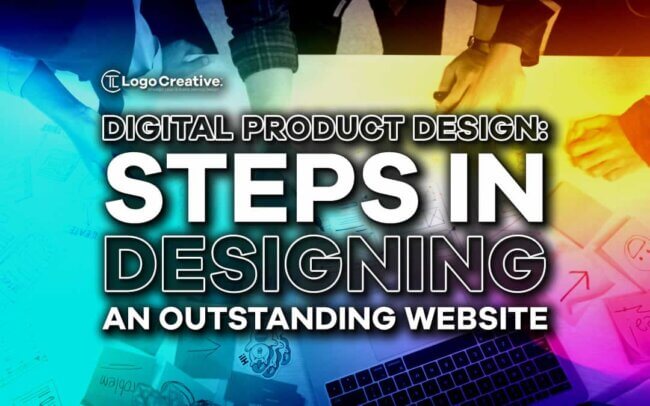In today’s digital age, having a compelling online presence is vital for any business or individual looking to succeed on the web. In this article we take a look at Digital Product Design: Steps in Designing an Outstanding Website.
Your website serves as your digital storefront, and its design plays a pivotal role in attracting, engaging, and retaining visitors. Read on to learn the essential steps of digital product design that will help you create an outstanding website that not only looks fantastic but also performs exceptionally well.
Table of Contents
Before You Start Designing
Before we jump into the nitty-gritty of web design, it’s crucial to understand how to build the foundation of a successful design. Here’s how to get started:
1. Define Your Objectives and Audience
The foundation of any outstanding website design is a clear understanding of your objectives and your target audience. Ask yourself:
- What are the primary goals of your website?
- Who is your target audience? What needs, preferences, and pain points do they have?
- What action do you want your visitors to take when they land on your website?
By answering these questions, you’ll lay the groundwork for a website that aligns perfectly with your business objectives and appeals directly to your audience.
2. Conduct Thorough Research
Research is a cornerstone of effective digital product design. Take the time to explore your industry, competitors, and the latest design trends. Here’s how to go about it:
- Analyze your competitors’ websites. Identify what works and what doesn’t.
- Follow the news in design and technologies.
- Conduct user surveys or interviews to gather insights directly from your target audience.
Armed with this information, you can make informed decisions about the design elements that will set your website apart.
The Website Design Process
Now that we’ve laid the groundwork, let’s move on to the actual design process. To make sure your product is developed in the best way possible from the start, cooperate with a web design agency that can efficiently coordinate all these processes.
3. Wireframing and Prototyping
Wireframing is the process of creating a basic layout of your website, outlining where elements like navigation menus, content sections, and call-to-action buttons will go. Prototyping, on the other hand, involves creating interactive mockups to test user interactions and flows.
4. Visual Design
Visual design is where the aesthetics of your website come into play. This includes selecting color schemes, typography, and imagery that resonate with your brand and appeal to your audience. Visual design should be consistent with your brand identity and create a cohesive user experience.
5. Responsive Design
In today’s mobile-centric world, responsive design is non-negotiable. Ensure that your website looks and functions seamlessly on various devices, from desktops to smartphones and tablets. While responsive design plays a huge role in the quality of user experience, it is also important for your SEO rankings.
6. Content Creation
“Content is king,” they say, and it holds true for websites as well. Create high-quality, engaging content that informs, entertains, or solves problems for your audience. Your content should have a good structure, be easy to read, and be optimized for search engines.
7. User Testing
Before launching your website, conduct thorough user testing to identify and rectify any usability issues. This step is crucial for ensuring that your website provides a seamless and enjoyable experience for visitors.
8. Launch and Continuous Improvement
Once you’ve addressed all the design elements and conducted user testing, it’s time to launch your website. But the work doesn’t end there. Continuously monitor your website’s performance, gather user feedback, and make improvements as needed to enhance user satisfaction and achieve your goals.
SEO Optimization
Now that you have a stunning and user-friendly website, let’s talk about the importance of SEO optimization. After all, your site won’t make an impact if it can’t be found on search engines like Google.
9. Keyword Research
Keyword research is the foundation of effective SEO. Start by choosing relevant keywords that your target audience is likely to search for. You can use free tools like Google Keyword Planner to discover and analyze high-traffic, low-competition keywords.
10. On-Page SEO
Your website’s on-page elements, including meta titles, meta descriptions, headers, and image alt text, should be well-optimized, too. Ensure that your content is not only informative but also incorporates your target keywords naturally.
11. Off-Page SEO
Off-page SEO involves building high-quality backlinks to your site from authoritative sources. Guest posting, social media promotion, and influencer collaborations are effective strategies for off-page SEO.
12. Monitor and Adapt
SEO is an ongoing process. Continuously monitor your website’s search engine rankings, traffic, and conversion rates. Adapt your SEO strategy based on performance data and algorithm updates.
Conclusion
By following the steps outlined in this guide and staying committed to providing value to your audience, you can create a website that not only ranks high on Google but also leaves a lasting impression on your visitors. Remember, the key to success lies in understanding your audience, staying updated on industry trends, and continuously improving your website’s design and content.
Join The Logo Community
We hope you enjoyed these 5 Reasons Why Web Design Impacts Content Marketing. If you would like more personal tips, advice, insights, and access to our community threads and other goodies, join me in our community. You can comment directly on posts and have a discussion.
*TIP – We use and recommend DesignCuts for all your fonts, mockups and design bundles.


